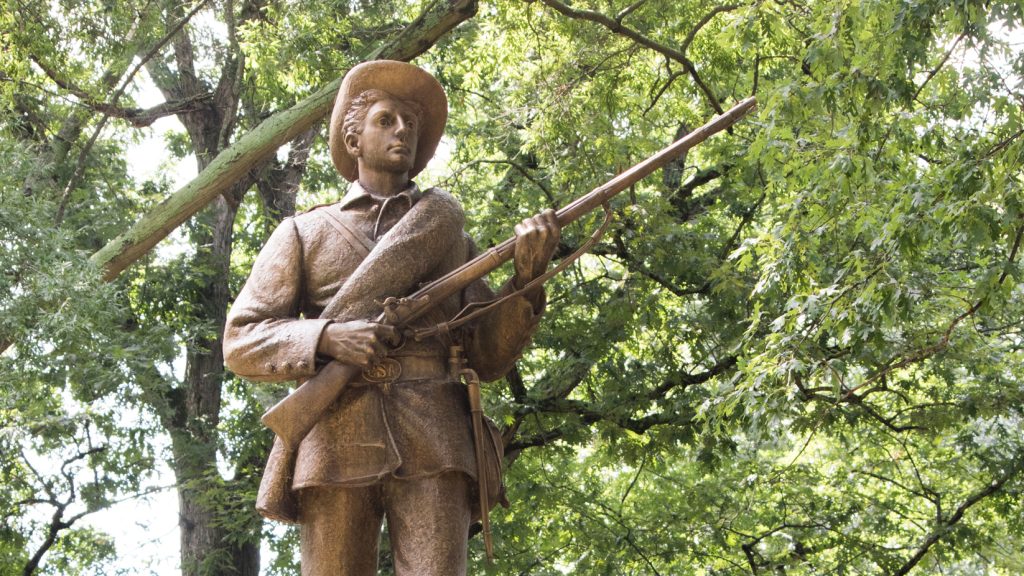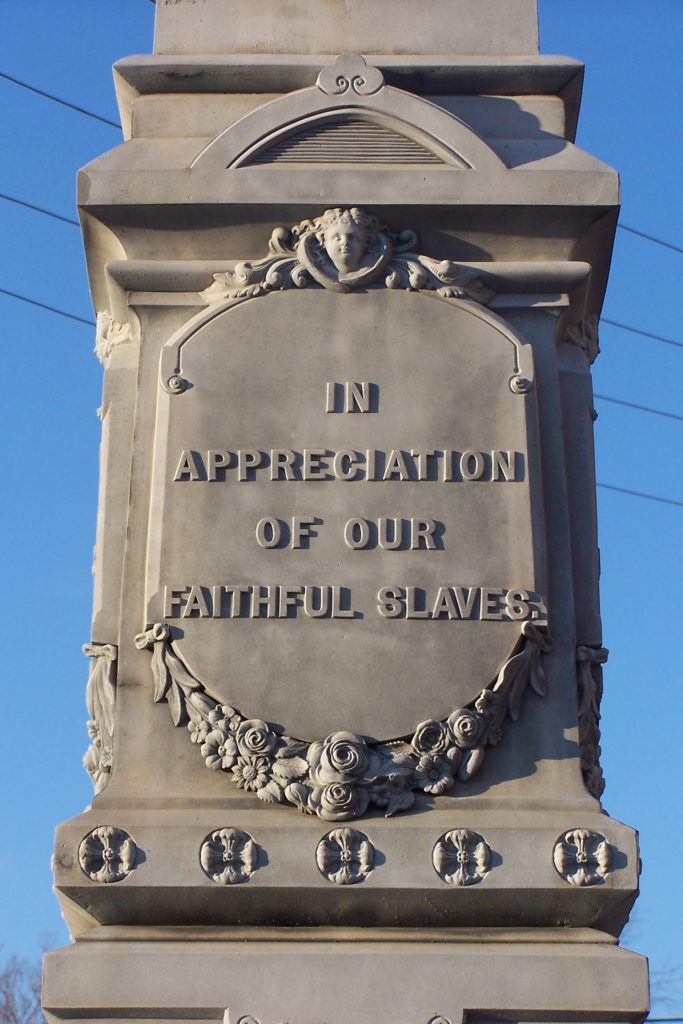Of Monuments and Memorials: ‘Silent Sam’ and Other Disquieting Reminders of the American Past
Updated Jan. 29, 2025
“Congress shall make no law respecting an establishment of religion, or prohibiting the free exercise thereof; or abridging the freedom of speech, or of the press; or of the right of the people peaceably to assemble, and to petition the Government for a redress of grievances.”

Case Study: ‘Silent Sam’
A swarm of angry protestors tore down a towering bronze effigy of a Confederate soldier at the University of North Carolina, Chapel Hill in 2018. The statue, named “Silent Sam,” had loomed over campus for more than a century. The downfall of Silent Sam sparked backlash on campus, but also struck a chord across the country, once again bringing the conversation on Confederate monuments to the forefront.
The incident became a flashpoint in an ongoing debate about public memorials that recall problematic moments and issues in American history. Proponents of tearing down Confederate statues and other remembrances of prominent racists say the memorials serve as reminders of a painful past; opponents, meanwhile, argue for the historical and cultural value of these markers. From debates on college campuses to the deadly 2017 riot in Charlottesville, Virginia, the controversy over Confederate monuments has fueled uproar in myriad communities, especially in the American South. But perhaps even more fundamentally, the felling of Confederate monuments encapsulates the lasting tension between Free Speech and the dark side of history.
Click here to familiarize yourself with the circumstances surrounding “Silent Sam” through the Free Speech Tracker entry on the subject
The Incident and Its Aftermath
- History speaks on intentions behind Confederate statues, The News & Observer, August 2017
- Silent Sam toppled in protest the night before classes begin, The Daily Tar Heel, August 2018
- 3 Are Charged in Toppling of ‘Silent Sam’ Statue, The New York Times, August 2018
- Duke history professors ask to rename building honoring white supremacist who dedicated ‘Silent Sam’ statue, The Washington Post, August 2018
- UNC faculty members, in letter to parents, support Silent Sam strike and withholding grades, The News & Observer, December 2018
- ‘It’s a disgrace’: UNC will give Silent Sam to Sons of Confederate Veterans after suit, The Daily Tar Heel, November 2019
Silent Sam is certainly not the only monument to stir trouble in recent years. Check out other similar tracker entries below:
Related Incidents from the Free Speech Tracker
- Charlottesville march results in violence, death — August 2017
- Dallas mayor and city council sued for prohibiting removal of Confederate leaders’ names from city streets — April 2018
- Satanic statue unveiled at Arkansas capitol building to protest Christian monument — August 2018
- Mary Baldwin University in Virginia removes art exhibit on Confederate monuments — November 2018
- San Francisco high school’s Depression-era murals spark censorship debate — August 2019
- Protesters topple statues of racist historical figures across the country, following killing of George Floyd — June 2020
- Florida principal resigns after art class exposes students to Michelangelo statue – March 2023
Other Related Incidents
Nearly 100 Confederate Monuments Removed in 2020, Report Says; More Than 700 Remain, NPR, February 2021
Jacksonville, Florida, mayor has Confederate monument removed after years of controversy, AP News, December 2023
Judge allows removal of Confederate statue at Arlington National Cemetery amid protests, ABC News, December 2023
A Confederate statue in North Carolina praises ‘faithful slaves.’ Some citizens want it gone, USA Today, May 2024
RFK Jr. condemns the removal of Confederate monuments, Jonathan Cooper, Associated Press, May 2024
The Role of Free Speech
- Blocked from taking Confederate statues down, Atlanta, Birmingham, Memphis try other ideas, USA Today, February 2019
- Norfolk sues to remove Confederate monument, citing free speech, AP News, August 2019
- Judge Blocks Removal Of Confederate Statue That Sparked Charlottesville Protest, NPR, September 2019
- Group argues Confederate statue removals at UT violate free speech, CBS Austin, October 2019
- Confederate Monument Law Upheld By Alabama Supreme Court, NPR, November 2019
- Virginia Cities Now Have the Power To Remove Confederate Statues, DCist, April 2020
- Pennsylvania Court Lets Suit Over Removal of Columbus Statue Go Forward, Reason Magazine, April 2024
- UVA Takes Down a Statue, Takes Up Free Speech, UVA Magazine, Fall 2021
- Pensacola wins Confederate monument lawsuit, statue will stay down, Pensacola News Journal, January 2024

Point/Counterpoint
- Wilson Perfectly Embodies U.S. Hypocrisy. That’s Why We Should Remember Him., Stephen Kinzer, POLITICO Magazine, December 2015
- Great people in history have done horrible things. Should we stop honoring them?, Sanford J. Ungar, The Washington Post, January 2016
- Take the Statues Down, Yoni Appelbaum, The Atlantic, August 2017
- Confederate Statues Honor Timeless Virtues — Let Them Stay, Arthur Herman, National Review, August 2017
- As monuments to the Confederacy are removed from public squares, new ones are quietly being erected, Jenny Jarvie, Los Angeles Times, October 2017
- Of Monuments and Power: Public Art Debates Are More Than Just Free Speech vs. Censorship, Svetlana Mintcheva, National Coalition Against Censorship, December 2018
- I’m an archaeologist. I don’t worry removing monuments will erase history, Ben Steere Citizen Times, July 2020
- I’m a scholar of white supremacy who’s visiting all 113 places where Confederate statues were removed in recent years − here’s why Richmond gets it right, The Conversation, December 2024
Discussion Questions
- If monuments to Confederate leaders, slaveholders, and other prominent racists are to be taken down, where does one draw the line? Should the Jefferson Memorial on the Tidal Basin in Washington, D.C., be removed? The Washington Monument? Does tearing down just a few notorious Confederate monuments create a slippery slope?
- Opponents of Confederate monument removal often claim that they represent a valuable part of American history. Do these monuments have historical value? If so, does society have a responsibility to maintain this history, even if the historical messages are unnerving?
- Most Confederate monuments were not built in the aftermath of the Civil War, but rather during the rise of Jim Crow laws and into the dawn of the Civil Rights Movement – moments in the twentieth century when white supremacists sought to reassert their dominance, according to the Southern Poverty Law Center. Should this background and intent influence the discussion around the monuments’ removal today?
- Some cities have begun removing Confederate statues from cemeteries, while others have chosen to move contentious monuments into burial grounds, away from routine public view. Are cemeteries a possible compromise solution to the controversy, or simply a new front in the struggle?
- Consider the case at Mary Baldwin University, where artworks containing images of Confederate monuments were censored. How does this censorship conflict with basic principles of free speech? Can racist imagery be effectively reappropriated into art? How should audiences grapple with such art?
- Confederate monuments are not the only statues that find themselves in a thorny free speech situation: the case of the Satanic monument at the Arkansas state capitol building shows how monuments can themselves be a form of protest. Should there be limitations on what kind of monuments can be built on government property? Who should determine these limitations?
- The removal of controversial landmarks is an international issue. On April 3, 2020, the city of Prague removed a Communist-era statue memorializing a Russian general. Many Czechs view the monument as a relic of Soviet oppression during the Cold War, but the statue’s removal has drawn criticism from Russian government officials, who claim they should have been let in on the decision. What can we learn from foreign government interactions with monuments ? What are the similarities and differences between the Confederate case and others?
Activity
Click on these themes below: Protest Politics, Violence/Threats, Identity
Discuss: What patterns emerge? What does this confluence of stories tell us about Free Speech issues in the United States? Free Speech and memorialization?